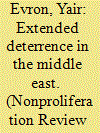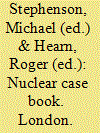| Srl | Item |
| 1 |
ID:
115296


|
|
|
|
|
| Publication |
2012.
|
| Summary/Abstract |
The article presents and analyzes the US extended deterrence commitments in the Middle East as well as those provided by regional states, and assesses the effectiveness and credibility of these commitments. The article then proceeds to analyze a situation wherein Iran successfully develops nuclear weapons. It considers first the security requirements and alternatives of Gulf Cooperation Council (GCC) states, and then proceeds to assess the stability-or instability-of an Israeli-Iranian nuclear balance. The enhancement of US extended deterrence in the region is required in order to deter Iran, reassure allies, and contribute to the stability of an Israeli-Iranian nuclear balance. The article also discusses several contextual issues, such as: the future form of US extended deterrence; distinguishing between the latter and other US extended deterrence commitments; and the different approaches of specific GCC states and Israel.
|
|
|
|
|
|
|
|
|
|
|
|
|
|
|
|
| 2 |
ID:
186186


|
|
|
|
|
| Summary/Abstract |
Does nuclear superiority offer states political or military benefits? And do those benefits accrue beyond acquiring a secure second-strike capability? International relations theory has long held that nuclear superiority does not confer significant advantages, a conclusion supported by much of the qualitative literature on bargaining and crisis interactions between nuclear-armed states. New work by scholars using statistical methods to analyze data on nuclear crises, interstate disputes, and compellent threats has sought to answer these questions, producing conflicting results. Despite the contributions of these recent works, this line of research has assumed that warhead counts are an appropriate measure of nuclear capabilities and that states possess accurate information about the material balance. Instead, states use multiple quantitative and qualitative characteristics to evaluate the nuclear balance, and they often have inaccurate or incomplete information about the size, composition, and configuration of other states' nuclear forces. Using new data, replications of two prominent recent works show that results are sensitive to how the nuclear balance is operationalized. Drawing on archival and interview data from the United States and the Soviet Union during the Cold War, findings show how states and leaders often understand and respond to the nuclear balance in inconsistent, asymmetric, and subjective ways.
|
|
|
|
|
|
|
|
|
|
|
|
|
|
|
|
| 3 |
ID:
060857


|
|
|
|
|
| Publication |
London, Frederick Muller Limited, 1983.
|
| Description |
144p.
|
| Standard Number |
0584110790
|
|
|
|
|
|
|
|
|
|
|
|
Copies: C:1/I:0,R:0,Q:0
Circulation
| Accession# | Call# | Current Location | Status | Policy | Location |
| 027545 | 355.0217/STE 027545 | Main | On Shelf | General | |
|
|
|
|
| 4 |
ID:
193526


|
|
|
|
|
| Summary/Abstract |
As North Korea succeeds in developing hydrogen bombs, ICBMs, and SLBMs capable of destroying U.S. cities, the current U.S. extended deterrence may not work. The United States must empower South Korea with a nuclear option to exercise its right of self-defense by prescribing an on-site nuclear balance. This article presents and compares two options for the United States: (1) South Korea’s nuclear armament and (2) another nuclear sharing system in Northeast Asia. As a result, this article recommends the second option with sea-borne sharing and incremental implementation.
|
|
|
|
|
|
|
|
|
|
|
|
|
|
|
|